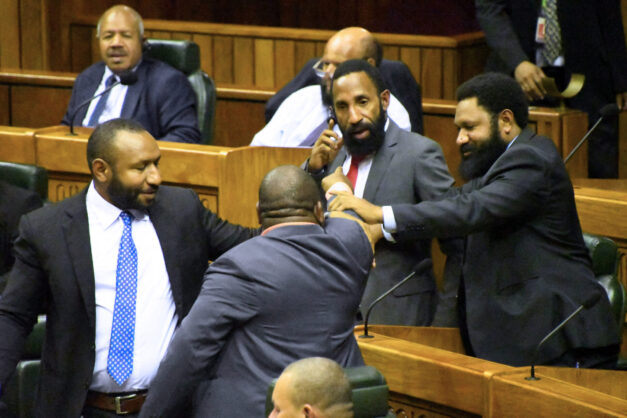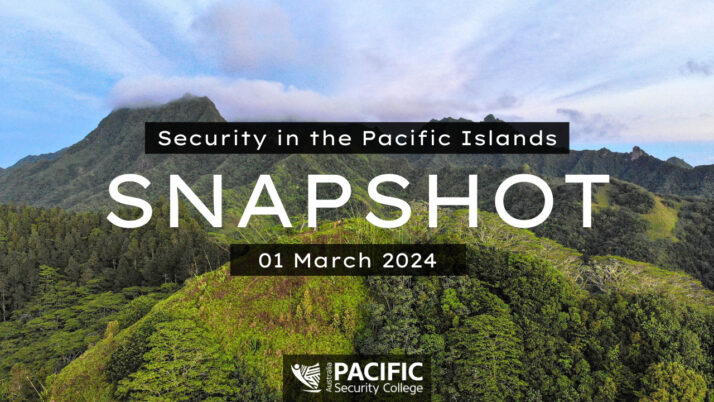Political instability in Papua New Guinea

Members of the parliament react during the session in Port Moresby on May 28, 2019. GORETHY KENNETH / AFP
A former leader has pointed to the length of prime ministerial terms as an indicator of stability in Papua New Guinea, but this does not tell the whole story, Henry Ivarature writes.
“There must be political stability to bring development”, argued Paias Wingti, Governor of Western Highlands Province and former prime minister of Papua New Guinea, in September 2021.
Wingti believes impact projects can only be delivered if governments serve an uninterrupted term in parliament. He blames mid-term changes of government for preventing development taking place. The governments of the late Sir Michael Somare and Peter O’Neill “delivered impact projects right around the country” because they “survived a full term”.
The benefits of stability can be debated. But what is often overlooked is that, even if a government survives a full (five-year) term, it might not be stable. Ministerial stability and longevity are also important in creating a stable policy environment.
My recent Asia & the Pacific Policy Studies article introduces a dataset that examines ministerial duration and stability in Papua New Guinea. The dataset covers 321 ministers and 15 governments from 1972 to 2017.
I use information on ministerial duration to calculate the average duration of all ministers during a government’s tenure (that is, under a single prime minister), and the average ministerial duration in a given portfolio during that government. The average duration of ministers for all 15 governments is 25.2 months. This is about half the term of parliament. The average ministerial duration per portfolio for all governments is 12.3 months.
I also use these averages to construct two stability indicators to measure ministerial stability under each prime minister. Stability Indicator 1 divides the average durations of all ministers in each government (including prime ministers) by the tenure of the prime minister to measure ministerial stability.
Stability Indicator 2 divides the average ministerial duration in a portfolio by the length of the prime minister’s tenure to measure portfolio ministerial stability.
Both stability indicators range between zero and one, with zero indicating low ministerial stability and one indicating high ministerial stability.
Stability Indicator 1 ranges from 0.55 to 0.97 with an average of 0.72. Three governments that experienced exceptionally high ministerial stability were those under the prime ministerships of Wingti (0.97, third parliament and 0.91, fifth parliament) and O’Neill (0.97, eighth parliament). In these governments, ministers were only rarely removed from their roles during the term of the government, and the average minister lasted for almost as long as the prime minister.
The governments that measured the lowest on this indicator were those of Morauta (sixth parliament) at 0.59 and Somare (seventh parliament) at 0.55. In these governments, the average minister only lasted for a little more than half as long as the PM.
The average for Stability Indicator 2 is 0.39. O’Neill’s government in the eighth parliament had the highest score on this indicator at 0.65.
Ministers changed portfolios comparatively rarely during the lifespan of this government. The governments of Morauta (sixth parliament) and Somare (seventh parliament) scored the lowest with averages of 0.20 and 0.23, respectively. This means that during the time of these prime ministers, there were on average five or four ministers for each portfolio.
Although both Somare and O’Neill enjoyed full terms in office, ministerial stability varied significantly between them. O’Neill’s 2012-17 government experienced high stability on Indicator 1 but low stability on Indicator 2.
Somare’s government, on the other hand, experienced low stability on both indicators, despite the Organic Law on the Integrity of Political Parties and Candidates being operational during his tenure (the law was meant to promote stability, and was subsequently in large part overturned by the courts). In other words, Somare kept changing his ministers, and O’Neill retained the same ministers but kept reshuffling their portfolios.
My article provides further explanation for the variation in ministerial duration and stability seen across governments. Looking at the post-independence period as a whole, while there is no clear evidence of ministerial stability either improving or worsening – on average ministerial stability is low and portfolio ministerial stability very low.
For prime ministerial stability to be a benefit in the way that Wingti suggests, then not just prime ministerial but ministerial tenures need to be increased. There should be less reshuffling of ministers, and less reshuffling of portfolios. Without that, policy continuity and policy coherence, and indeed political stability itself, are likely to remain elusive.
Henry Ivarature
This article was originally published on Devpolicy Blog. It is based on an article in the Asia & the Pacific Policy Studies journal, ‘The hidden dimension to political instability: Insights from ministerial durations in Papua New Guinea from 1972 to 2017’, by Henry Ivarature. The database on which the article is based is also available. All articles in the journal are free to read and download.
More Stories

Security Snapshot - 28 Mar 2024
Pacific Security Snapshot | 28 March 2024
Summary ➣ Heavy rains, floods, landslides and earthquakes batter the region ➣ Pacific submissions to the International Court of Justice (ICJ) on climate change responsibility ➣ Elections across the Pacific prompting changes to diplomatic relations and security arrangements ➣ Challenges for women in politics Climate Security Lives have been lost in PNG after a series…

Security Snapshot - 1 Mar 2024
Pacific Security Snapshot | 01 March 2024
The security stories shaping the region ➣ Pacific Islands Leaders Meeting (PALM) to be held in Tokyo in July 2024 ➣ 2023 warmest year on record, globally ➣ Elections across the Pacific prompting changes to diplomatic relations and security arrangements ➣ Extractive industries booming ➣ Environmental conservation efforts ongoing ➣ PNG riots shed light on…






